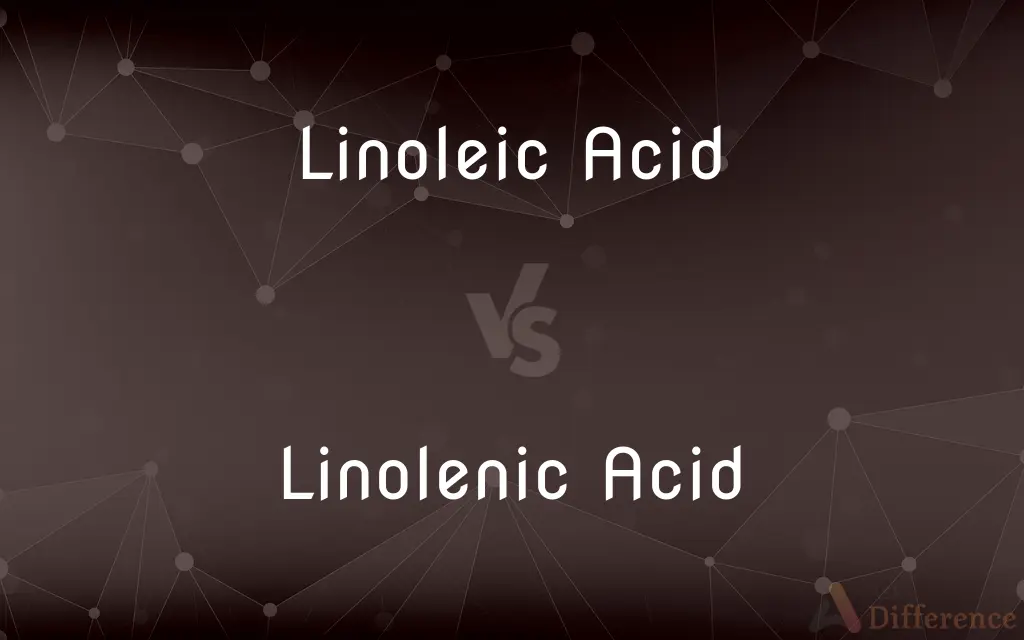Linoleic Acid vs. Linolenic Acid — What's the Difference?
By Tayyaba Rehman — Published on November 7, 2023
Linoleic Acid (LA) is an omega-6 fatty acid, while Linolenic Acid (ALA) is an omega-3 fatty acid. Both are essential polyunsaturated fats, but they differ in molecular structure and function.

Difference Between Linoleic Acid and Linolenic Acid
Table of Contents
ADVERTISEMENT
Key Differences
Chemical Structure: Linoleic Acid has two double bonds in its molecular structure, classifying it as an omega-6 fatty acid. Linolenic Acid, contrastingly, has three double bonds, making it an omega-3 fatty acid. The distinction of "omega" indicates the position of the first double bond from the end of the fatty acid chain.
Dietary Sources: Linoleic Acid is predominantly found in vegetable oils like safflower, sunflower, and corn oil. Linolenic Acid can be found in flaxseed, chia seeds, and walnuts. Thus, while both are present in various foods, their primary sources differ.
Health Implications: Linoleic Acid plays a role in brain function and normal growth and development. An excess, however, has been linked to inflammation and other health issues. Linolenic Acid, meanwhile, has anti-inflammatory properties and is crucial for heart and brain health.
Metabolism in the Body: When consumed, the body can convert Linoleic Acid to longer-chain omega-6 fats. Linolenic Acid can be converted into longer-chain omega-3 fats, which include EPA and DHA, both beneficial for cardiovascular health.
Essentiality: Both Linoleic Acid and Linolenic Acid are deemed essential fatty acids, meaning the body cannot produce them on its own. They must be obtained through diet to ensure optimal health.
ADVERTISEMENT
Comparison Chart
Chemical Structure
Omega-6 with 2 double bonds
Omega-3 with 3 double bonds
Dietary Sources
Vegetable oils (safflower, sunflower)
Flaxseed, chia seeds, walnuts
Health Benefits
Brain function, growth
Anti-inflammatory, heart and brain health
Metabolic Products
Converts to longer-chain omega-6 fats
Converts to EPA and DHA
Essentiality
Essential fatty acid
Essential fatty acid
Compare with Definitions
Linoleic Acid
An acid that plays a role in brain function and growth.
A deficiency in Linoleic Acid can lead to skin issues.
Linolenic Acid
A fatty acid with three double bonds in its structure.
Linolenic Acid is known for its anti-inflammatory properties.
Linoleic Acid
A fatty acid with two double bonds in its structure.
Linoleic Acid is vital for maintaining the skin's water barrier.
Linolenic Acid
An acid crucial for cardiovascular and brain health.
Incorporating Linolenic Acid in the diet can benefit overall well-being.
Linoleic Acid
An essential omega-6 polyunsaturated fatty acid.
Safflower oil is a rich source of Linoleic Acid.
Linolenic Acid
An essential omega-3 polyunsaturated fatty acid.
Flaxseeds are a great source of Linolenic Acid.
Linoleic Acid
A fat that must be obtained through the diet as the body can't produce it.
Linoleic Acid supports proper cellular function.
Linolenic Acid
A necessary fat that the body cannot synthesize.
Linolenic Acid can be converted into EPA and DHA in the body.
Linoleic Acid
Predominantly found in plant-based oils.
The majority of vegetable oils contain high levels of Linoleic Acid.
Linolenic Acid
Primarily found in specific seeds and nuts.
Chia seeds are rich in Linolenic Acid and are often recommended for heart health.
Common Curiosities
How do Linoleic Acid and Linolenic Acid differ structurally?
Linoleic Acid has two double bonds (omega-6), while Linolenic Acid has three (omega-3).
Is one more beneficial than the other?
Both are essential, but a balance between the two is recommended for optimal health.
What are the health benefits of Linolenic Acid?
It has anti-inflammatory properties and supports heart and brain health.
Are both Linoleic Acid and Linolenic Acid essential for the body?
Yes, both are considered essential fatty acids that must be obtained through the diet.
Do most people consume enough of these acids?
Many consume adequate Linoleic Acid but may lack sufficient Linolenic Acid.
Why is the balance between Linoleic Acid and Linolenic Acid important?
A balanced ratio reduces the risk of inflammation and supports overall health.
Which foods are rich in Linoleic Acid?
Vegetable oils like safflower and sunflower are high in Linoleic Acid.
Are there health risks associated with excessive Linoleic Acid?
Excessive Linoleic Acid intake can lead to inflammation and other issues.
Can cooking destroy Linoleic or Linolenic Acid?
Excessive heat can degrade them, so cold-pressed or raw sources are best.
Where can I find Linolenic Acid in my diet?
Linolenic Acid is abundant in flaxseeds, chia seeds, and walnuts.
How do I know if I'm getting enough Linoleic and Linolenic Acid?
A balanced diet with varied sources usually ensures adequate intake, but blood tests can confirm levels.
Are supplements available for these acids?
Yes, both can be found in supplement form for those needing extra intake.
Can the body convert these acids into other compounds?
Yes, Linoleic can convert to other omega-6 fats, and Linolenic can convert to EPA and DHA.
Is it possible to consume too much Linolenic Acid?
While rare, excessive Linolenic Acid can lead to bruising or bleeding issues.
Are there any conditions related to a deficiency in these acids?
Deficiencies can lead to skin issues, poor wound healing, and other symptoms.
Share Your Discovery

Previous Comparison
Percent Yield vs. Percent Recovery
Next Comparison
Ajax vs. JQueryAuthor Spotlight
Written by
Tayyaba RehmanTayyaba Rehman is a distinguished writer, currently serving as a primary contributor to askdifference.com. As a researcher in semantics and etymology, Tayyaba's passion for the complexity of languages and their distinctions has found a perfect home on the platform. Tayyaba delves into the intricacies of language, distinguishing between commonly confused words and phrases, thereby providing clarity for readers worldwide.













































